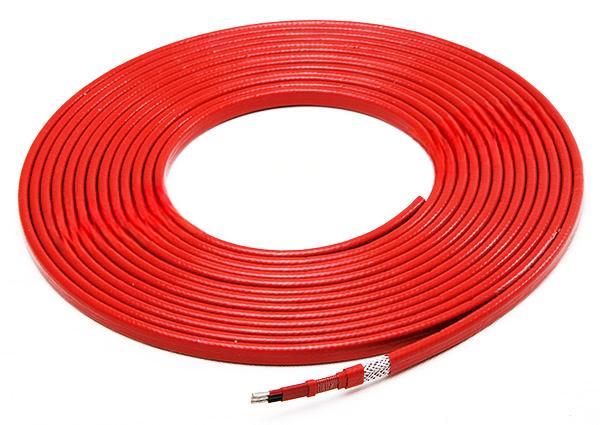In the field of industrial antifreeze and thermal insulation, electric heating cables play a key role. The quality of electric heating cables is directly related to the safety, stability and long-term effectiveness of system operation. As a professional electric heating cable manufacturer, we are well aware of the concerns of users when choosing products. The following is a multi-dimensional analysis of how to distinguish the quality of electric heating cables:

Core materials: the cornerstone of performance
- Conductor materials: High-quality products use high-purity, high-resistivity alloy wires (such as nickel-chromium alloys) or specially treated copper core wires to ensure stable resistance, uniform heating and high tensile strength. Inferior products often use impure alloys or copper-clad steel, which are prone to resistance drift, easy to break and short life.
- PTC core belt material: The core lies in the formula and process of polymer PTC materials. High-quality core belts have steep PTC effects (resistance rises sharply with temperature), excellent temperature self-control accuracy (such as within ±5℃) and long-term stability. Poor quality core belt has weak PTC effect, temperature is easy to get out of control, aging speed is fast, and there is a risk of overheating.
- Insulation sheath: The material must be strictly selected according to the use environment (temperature, chemical corrosion, mechanical wear, ultraviolet light). Common high-quality sheaths include modified polyolefins and fluorinated polymers (FEP/PFA). Poor quality products use ordinary PVC or recycled materials, which are prone to aging and cracking, poor temperature resistance and corrosion resistance, resulting in short circuit or failure.
- Metal braid/shield: For explosion-proof or mechanical protection occasions, a high coverage (≥80%) tinned copper wire or stainless steel wire braid should be used to provide a good grounding path, electromagnetic shielding and tensile strength. Poor quality products are sparsely woven, the material does not meet the standard, and the protection ability is in vain.
Structural design and process: Reliability guarantee
- Cold end (power lead) process: This is the stress concentration point. High-quality products use an integrated vulcanization process to ensure that the insulation layer and the sheath, the conductor and the heating cable body are firmly sealed and gapless, eliminating the risk of moisture intrusion and pull-off. Inferior products are simply injection molded or wrapped with tape, which is very easy to crack and infiltrate water after hot and cold cycles.
- Joint and terminal sealing: Joints in explosion-proof occasions must be fully sealed and meet the corresponding explosion-proof level (such as IP68). High-quality products use special injection molding joints or cold shrink technology. Poor sealing of inferior joints is the source of safety hazards.
- Structural uniformity: The materials of each layer of the heating cable cross section should be evenly distributed and of uniform thickness. Inferior products often have eccentricity and uneven thickness, resulting in local overheating or performance degradation. It can be detected by observing the cross section or professional equipment.
Performance parameters and certification: objective scale
- Temperature level and maintenance temperature: clearly mark the maximum exposure temperature, maximum maintenance temperature and maximum surface temperature (Ts), and meet the application requirements. Be careful when selecting those with vague or false parameters.
- Starting current and steady-state current: The starting current (cold state) of high-quality self-limiting temperature heating cables is reasonable and can decay quickly to a lower steady-state current. If the starting current is too high or decays slowly, it means that the PTC performance is poor and may cause impact on the power supply.
- Power output and temperature distribution: At the nominal voltage and reference temperature, the deviation between the measured power and the nominal value should be within a reasonable range (such as ±10%). The overall heating of the heating cable should be uniform and stable, without abnormal hot spots.
- Key certifications: Authoritative certification is an endorsement of safety and performance. Necessary certifications include:
- Explosion-proof certification: such as ATEX, IECEx, etc., clearly mark the applicable gas/dust group and temperature group.
- Safety certification: such as CSA, CE, etc.
- Performance test report: such as standard test reports such as IEC 60800, IEEE 515, etc.
Manufacturer’s strength and service: invisible value
- R&D and quality control capabilities: professional laboratories (material analysis, electrical properties, aging, environmental simulation testing), strict production process control (such as online spark detection, insulation withstand voltage testing) and a complete factory inspection process.
- Application experience and technical support: Can you provide professional selection design, installation guidance, system debugging and fault diagnosis services? Is there a rich library of successful cases?
- Warranty and after-sales: A clear warranty period and an efficient after-sales response mechanism are a manifestation of confidence.
Beware of common “traps” of inferior products
- Abnormally low prices: far below the reasonable market price, often means cutting corners on core materials, processes or certifications.
- Parameters are unclear or exaggerated: such as “universal”, “ultra-high temperature”, “never decay” and other false descriptions.
- Missing or falsified certification information: unable to provide valid certification certificates or reports, or certificate information does not match the product.
- Rough workmanship: uneven appearance, uneven thickness of sheath, loose braided layer, blurred or easy to fall off logo.
- No reliable traceability information: lack of clear production batch number, unique code, etc., once a problem occurs, it is difficult to hold accountable.
Choosing high-quality electric heating cables is not a simple price comparison, but a comprehensive consideration of system safety, operational reliability and long-term economic benefits. As a responsible manufacturer, we are well aware that only by adhering to the material, process, inspection and service barriers can we provide customers with trustworthy heating solutions. Before making a purchasing decision, be sure to conduct in-depth investigation and verification from multiple dimensions such as material composition, process details, performance data, authoritative certification and comprehensive strength of the manufacturer. A wise choice will build a solid and reliable safety and insulation barrier for your pipelines, equipment and production processes.
Post time: 2025-07-21




